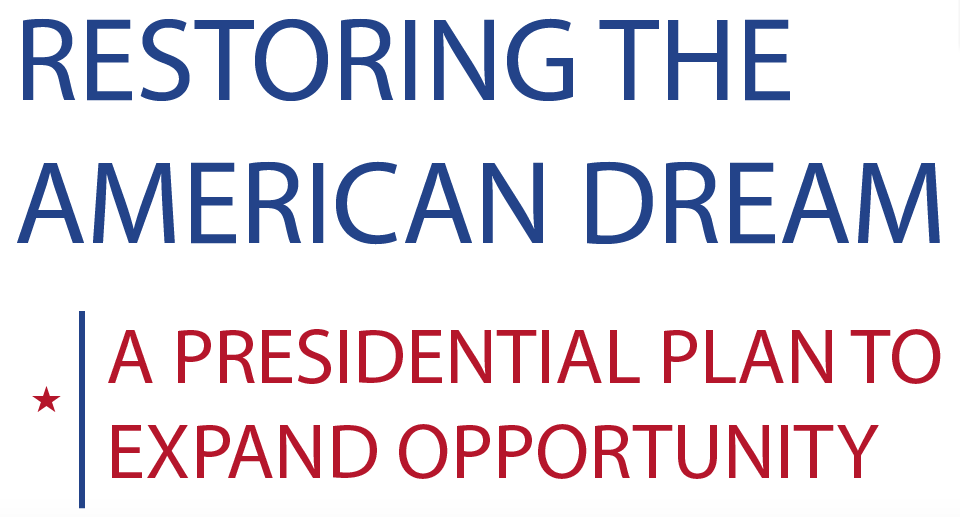 Opportunity Nation calls on all 2016 Presidential candidates to make clear their specific plans to restore access to the American Dream for one of our most valuable assets: our youth. Guided by cross-sector, bipartisan solutions that work across the country – from cities and suburbs to rural settings and tribal lands – the priorities outlined below reflect our vision of how we become a true opportunity nation.
Opportunity Nation calls on all 2016 Presidential candidates to make clear their specific plans to restore access to the American Dream for one of our most valuable assets: our youth. Guided by cross-sector, bipartisan solutions that work across the country – from cities and suburbs to rural settings and tribal lands – the priorities outlined below reflect our vision of how we become a true opportunity nation.
Download Our Presidential Plan |
|
 |
Establish the White House Office of OpportunityGoals of this Office: |
 |
Update Career and Technical EducationAdvance policy initiatives that would expand and improve hands-on, modernized career and technical education for all students. Increased collaboration among K-12 education, postsecondary education and the private sector, which understands the broad workforce needs of the community, will provide students with opportunities to gain academic and technical skills needed to succeed in postsecondary education, training and employment. |
 |
Incentivize Employers to Hire and Train YouthOffer tax credits to businesses that create apprenticeship programs linked to local workforce needs. Encourage government procurement officers and private-sector businesses to contract services with organizations that employ “opportunity youth” who are most at risk for disconnection from work and school. (These at-risk groups include, but are not limited to: low-income; special education; disabled; foster care children and those aging out of the system; and post-adjudicated youth.) |
 |
Encourage Cross-Sector CollaborationIncentivize collaboration among schools, employers and local workforce investment boards to leverage expertise and resources that can help students and youth who have left school to find a pathway to a meaningful career that includes access to internships and apprenticeships. Help all young adults understand their education and career options. |
 |
Provide Comprehensive Program Design and Wrap-Around Support ServicesGiven the wide range of needs and unique challenges facing many youth who are off-track or who did not graduate from high school, it is essential to ensure the right combination of services are available for all young adults. This includes offering students flexible schedules; pathways to reduce “seat time barriers” by allowing students to graduate without having spent a specific period of time in a classroom; re-entry programs for youth who have dropped out of school; and alternative programs provided outside the regular high school setting. Also needed are “early warning systems” that identify students at risk of dropping out and provide them with services designed to keep them in school and help ensure their continued progress. Schools and communities must work together to provide wrap-around support services. These include academic and career planning; mentoring; tutoring; summer employment programs; work-based learning experiences; mental health and other academic, career and social supports demonstrated to be effective in helping students in graduate or assisting dropouts in reenter school and complete a high school education. |
 |
Advance Juvenile and Criminal Justice ReformSupport bipartisan policy solutions that give offenders a second chance at the American Dream by demonstrating the value to employers and communities of hiring young offenders and by removing barriers such as eliminating restrictive licensing requirements and expunging records that could prevent a young offender from advancing on the education and career pathways ladder. Criminal justice reform would prevent youthful mistakes from turning into a lifetime of crime and help young adults who commit crimes become more self-reliant and contribute to their community in positive ways. |
 |
Expand Access to High-Quality Childhood Education Programs for Low- and Moderate-Income FamiliesAcross the country, there is strong bipartisan support for investments in high-quality pre-kindergarten by both elected officials and by voters. Investing in early childhood education is a critical component to advancing two generations in a family, particularly for young parents. Support for expanding pre-k is buoyed by powerful research about child brain development in the early years; short and long-term academic and social benefits; and overall cost effectiveness for local, state and federal governments. Now is the time to act by ensuring that all low- and moderate-income children have access to high-quality early education programs. |
 |
Improve Affordability, Quality and Financial Aid Access in Postsecondary EducationEvery young American needs some form of training or education after high school in order to get a good job and advance up the career ladder. But higher education remains out of reach for too many young adults. Promote efforts to revamp remedial education; hold institutions accountable for results; and promote broader access to apprenticeships and postsecondary programs, particularly in STEM, business, advanced manufacturing and health care fields. |
 |
Support College Savings Plans for Low-Income ChildrenFor many families, saving for education, a home or retirement is key to making economic progress. Unfortunately, most low-income families lack the resources to save for the future. Research shows that low-income children who have a college savings account in their names are at least three times more likely to attend college and four times more likely to graduate than their peers who lack such higher education savings accounts for various forms of training and education after high school. |
 |
Expand and Make Permanent the Earned Income Tax CreditRecognized as one of the most effective anti-poverty programs of the past 40 years, the EITC has benefited millions of low-income families and should be expanded to help lift more Americans out of poverty, particularly adults without children and non-custodial parents who currently are shut out of this program. |
 |
Accelerate Access to High-Speed InternetSeveral studies have shown that fast, reliable Internet access is essential to modern life, including applying for jobs, accessing services and managing finances. This is particularly important for students, residents in rural areas and low-income communities, and small businesses. Yet many Americans still lack this essential service. Bridging the “digital divide” by expanding access to high-speed Internet remains an important goal in order to expand opportunity to more Americans. |
 |
Strengthen Civic Engagement in CommunitiesCross-sector initiatives that promote volunteering and national service—and equal access to such opportunities—among all young adults can promote upward mobility and contribute to a range of positive outcomes that benefit both the individual and the community. Increased civic engagement can reduce youth disconnection and help young adults gain the skills and experience they need to embark on meaningful career pathways and bridge the growing opportunity divide. |








